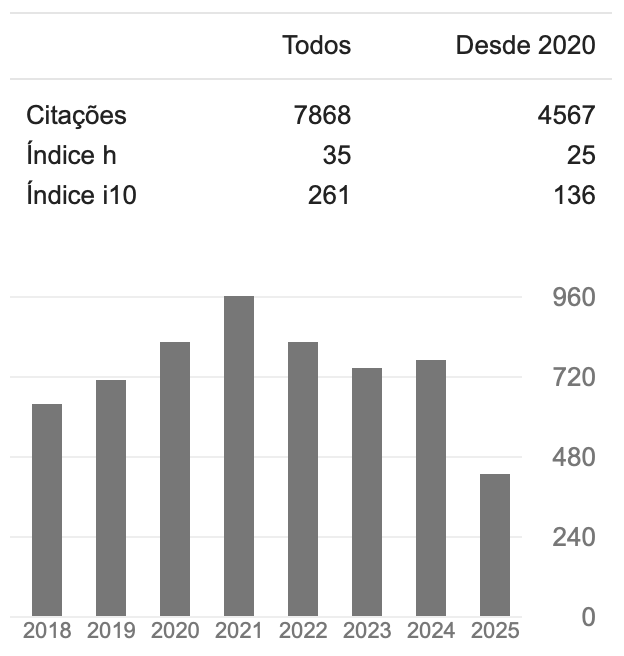Perfil funcional de pessoas com dores persistentes na coluna baseado na Classificação Internacional de Funcionalidade
DOI:
https://doi.org/10.17765/2176-9206.2023v16n4.e11913Palavras-chave:
Dor crônica, Dor nas costas, Avaliação da deficiênciaResumo
Traçar o perfil de funcionalidade de pessoas com dores persistentes na coluna por meio da Classificação Internacional de Funcionalidade, Incapacidade e Saúde (CIF). Trata-se de um estudo transversal com aplicação do método SCEBS (Somatic, Cognition, Emotion, Behavior and Social), Escala de catastrofização da dor, escala de cinesiofobia e percepção corporal. O discurso dos participantes foi analisado para identificação de conteúdos da CIF. O estudo incluiu 49 participantes com média de 25 anos. A partir do discurso foram identificadas 2.053 citações relacionadas a 108 diferentes categorias da CIF. As categorias mais identificadas foram: segmento vertebral lombar (s76002), funções relacionadas aos aspectos emocionais (b1522 e b152), cuidados da própria saúde (d570) e educação (d838). A catastrofização e cinesiofobia interferiram no perfil de funcionalidade dos participantes. As pessoas com dor persistente na coluna enfrentam prejuízos nas estruturas e funções corporais, limitação nas atividades e participação, fatores ambientais e pessoais.Downloads
Referências
1. Gogovor A, Visca R, Auger C, Bouvrette-Leblanc L, Symeonidis I, Poissant L, et al. Informing the development of an Internet-based chronic pain self-management program. Int J Med Inform. 2017 Jan;97:109–19. doi: 10.1016/j.ijmedinf.2016.10.005
2. Vos T, Lim SS, Abbafati C, Abbas KM, Abbasi M, Abbasifard M, et al. Global Burden of 369 Diseases and Injuries in 204 Countries and territories, 1990–2019: a Systematic Analysis for the Global Burden of Disease Study 2019. Lancet. 2020 Oct 17;396(10258):1204–22. doi: 10.1016/S0140-6736(20)30925-9.
3. Hashmi JA, Baliki MN, Huang L, Baria AT, Torbey S, Hermann KM, et al. Shape shifting pain: chronification of back pain shifts brain representation from nociceptive to emotional circuits. Brain. 2013 Aug 26;136(9):2751–68. doi: 10.1093/brain/awt211
4. Kamonseki DH, Christenson P, Rezvanifar SC, Calixtre LB. Effects of manual therapy on fear avoidance, kinesiophobia and pain catastrophizing in individuals with chronic musculoskeletal pain: Systematic review and meta-analysis. Musculoskelet Sci Pract. 2021 Feb;51:102311. doi: 10.1016/j.msksp.2020.102311
5. Turton AJ, Palmer M, Grieve S, Moss TP, Lewis J, McCabe CS. Evaluation of a Prototype Tool for Communicating Body Perception Disturbances in Complex Regional Pain Syndrome. Front Hum Neurosci. 2013;7. doi: 10.3389/fnhum.2013.00517.
6. Hutting N, Caneiro JP, Ong’wen OM, Miciak M, Roberts L. Patient-centered care in musculoskeletal practice: key elements to support clinicians to focus on the person. Musculoskeletal Sci and Pract. 2021 Aug;57:102434. doi: 10.1016/j.msksp.2021.102434.
7. Selb M, Escorpizo R, Kostanjsek N, Stucki G, Üstün B, Cieza A. A guide on how to develop an International Classification of Functioning, Disability and Health Core Set. 1st ed. Vol. 51. Eur J of Phys Rehabil Med; 2015.
8. Fréz AR, Binda AC, Dubiela A, Daniel CR, Bertolini GRF, Ruaro JA, et al. Funtional profile of active adults with low back pain, according to the ICF. Rev Bras Med Esporte. 2016; 22:252–5. doi.org/10.1590/1517-869220162204159647
9. Stucki G, Rubinelli S, Bickenbach J. We need an operationalisation, not a definition of health. Disabil and Rehabil. 2018 Oct 16;42(3):442–4. doi: 10.1080/09638288.2018.1503730.
10. Miller MB, Roumanis MJ, Kakinami L, Dover GC. Chronic Pain Patients’ Kinesiophobia and Catastrophizing are Associated with Activity Intensity at Different Times of the Day. J Pain Res. 2020 Jan;Volume 13:273–84. doi: 10.2147/JPR.S230039.
11. Bernardo Figueiredo B, de Sousa Dantas D, Oliveira TG, Cavalcanti GD, Reinaux C, Dornelas de Andrade A. Functioning profiles of individuals with Mucopolysaccharidosis according to the International Classification of Functioning. Eur J Phys and Rehabil Med. 2022 Mar;58(1). doi: 10.23736/S1973-9087.21.06881-7.
12. DB C. How Prevalent is Chronic Pain? Pain. 2003;11(2).
13. Postma SAE, van Boven K, ten Napel H, Gerritsen DL, Assendelft WJJ, Schers H, et al. The development of an ICF-based questionnaire for patients with chronic conditions in primary care. J Clin Epidemiol. 2018 Nov;103:92-100. doi: 10.1016/j.jclinepi.2018.07.
14. Santos MRP dos, Nogueira LC, Armando Meziat-Filho N, Oostendorp R, Reis FJJ dos. Transcultural adaptation into Portuguese of an instrument for pain evaluation based on the biopsychosocial model. Fisioter mov. 2017;30(suppl 1):183–95. doi.org/10.1590/1980-5918.030.S01.AO18
15. Vlaeyen JW, Kole-Snijders AM, Boeren RG, van Eek H. Fear of movement/(re)injury in chronic low back pain and its relation to behavioral performance. Pain. 1995 Sep 1;62(3):363–72. doi: 10.1016/0304-3959(94)00279-N
16. Van Oosterwijck J, Nijs J, Meeus M, Truijen S, Craps J, Van den Keybus N, et al. Pain neurophysiology education improves cognitions, pain thresholds, and movement performance in people with chronic whiplash: A pilot study. J Rehabil Res Dev. 2011;48(1):43. doi: 10.1682/jrrd.2009.12.0206.
17. Silva AN, Martins MRI. Pain, kinesiophobia and quality of life of low back pain patients. Rev dor. 2014;15(2). doi.org/10.5935/1806-0013.20140023
18. Sullivan MJL, Bishop SR, Pivik J. The Pain Catastrophizing Scale: Development and validation. Psychol Assess. 1995;7(4):524–32. doi.org/10.1037/1040-3590.7.4.524
19. Sehn F, Chachamovich E, Vidor LP, Dall-Agnol L, Custódio de Souza IC, Torres ILS, et al. Cross-Cultural Adaptation and Validation of the Brazilian Portuguese Version of the Pain Catastrophizing Scale. Pain Medicine. 2012 Nov;13(11):1425–35. doi: 10.1111/j.1526-4637.2012.01492.x
20. Sullivan M. The Pain Catastrophizing Scale: User Manual. Montreal: McGill University. 2009;1:1-36
21. Meier R, Iten P, Luomajoki H. Clinical assessments can discriminate altered body perception in patients with unilateral chronic low back pain, but not differences between affected and unaffected side. Musculoskelet Sci and Pract. 2019 Feb;39:136–43. doi: 10.1016/j.msksp.2018.12.006
22. Nishigami T, Mibu A, Osumi M, Son K, Yamamoto S, Kajiwara S, et al. Are tactile acuity and clinical symptoms related to differences in perceived body image in patients with chronic nonspecific lower back pain? Man Ther. 2015 Feb;20(1):63–7. doi: 10.1016/j.math.2014.06.010
23. Cieza A, Fayed N, Bickenbach J, Prodinger B. Refinements of the ICF Linking Rules to strengthen their potential for establishing comparability of health information. Disabil Rehabil. 2016 Mar 17;41(5):574–83. doi: 10.3109/09638288.2016.1145258
24. Geyh S, Schwegler U, Peter C, Müller R. Representing and organizing information to describe the lived experience of health from a personal factors perspective in the light of the International Classification of Functioning, Disability and Health (ICF): a discussion paper. Disabil Rehabil. 2018 Mar 6;41(14):1727–38. doi: 10.1080/09638288.2018.1445302.
25. Zaros L, Medeiros H. Bioestatistica. Natal; 2011.
26. Fernandes BHP, Gomes CR de G. Mecanismos e Aspectos Anatômicos da Dor. Saúde E Pesqui. 2011 Jul 8;4(2):237-246.
27. Stroud MW, Thorn BE, Jensen MP, Boothby JL. The relation between pain beliefs, negative thoughts, and psychosocial functioning in chronic pain patients. Pain. 2000 Feb;84(2):347–52. doi: 10.1016/s0304-3959(99)00226-2
28. Meeus M. Are Pain Beliefs, Cognitions, and Behaviors Influenced by Race, Ethnicity, and Culture in Patients with Chronic Musculoskeletal Pain: A Systematic Review. January 2018. 2018 Nov 14;1(21;1):541–58.
29. Turk DC, Fillingim RB, Ohrbach R, Patel KV. Assessment of Psychosocial and Functional Impact of Chronic Pain. Jour Pain. 2016 Sep;17(9):T21–49. doi: 10.1016/j.jpain.2016.02.006
30. Bonathan CJ, Zakrzewska JM, Love J, Williams A. Beliefs and Distress About Orofacial Pain: Patient Journey Through a Specialist Pain Consultation. J Oral Facial Pain a Headache. 2014 Jun;28(3):223–32. doi: 10.11607/ofph.1184
Downloads
Publicado
Como Citar
Edição
Seção
Licença
A submissão de originais para a revista Saúde e Pesquisa implica na transferência da Carta Concessão de Direitos Autorais, pelos autores, dos direitos de publicação digital para a revista após serem informados do aceite de publicação.A Secretaria Editorial irá fornecer da um modelo de Carta de Concessão de Direitos Autorais, indicando o cumprimento integral de princípios éticos e legislação específica. Os direitos autorais dos artigos publicados nesta revista são de direito do autor, com direitos da revista sobre a primeira publicação. Os autores somente poderão utilizar os mesmos resultados em outras publicações, indicando claramente a revista Saúde e Pesquisa como o meio da publicação original. Em virtude de tratar-se de um periódico de acesso aberto, é permitido o uso gratuito dos artigos, principalmente em aplicações educacionais e científicas, desde que citada a fonte. A Saúde e Pesquisa adota a licença Creative Commons Attribution 4.0 International.
A revista se reserva o direito de efetuar, nos originais, alterações de ordem normativa, ortográfica e gramatical, com vistas a manter o padrão culto da língua e a credibilidade do veículo. Respeitará, no entanto, o estilo de escrever dos autores. Alterações, correções ou sugestões de ordem conceitual serão encaminhadas aos autores, quando necessário. Nesses casos, os artigos, depois de adequados, deverão ser submetidos a nova apreciação. As opiniões emitidas pelos autores dos artigos são de sua exclusiva responsabilidade.


















